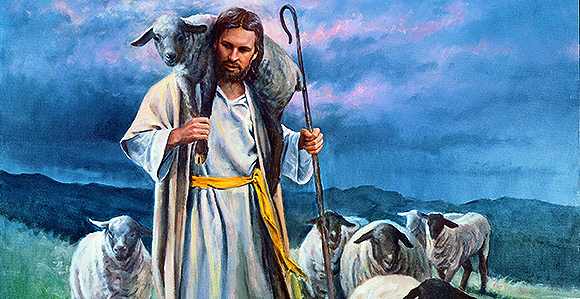Sister Marriott: “Make Us Thy True Under-Shepherds”
Contributed By Sister Neill F. Marriott of the Young Women general presidency

Good Shepherd by Del Parson portrays an image of a shepherd and his lambs. Young Women leaders are asking members to nurture the Lord’s flocks.
Article Highlights
- Let us nurture His flocks, our friends, fellow members, and families with love and sacrifice.
- As did the shepherds of old, may we come to Him with haste and then go our way glorifying and praising God.
“This Christmas, mend a quarrel. … Be kind. Be gentle. Laugh a little more. Express your gratitude. Welcome a stranger. Gladden the heart of a child. Take pleasure in the beauty and wonder of the earth. Speak your love and then speak it again.” —President Howard W. Hunter (1907–1995)
It was a spring night more than two millennia ago and quiet on the hills of Bethlehem. Certain shepherds stood watch over the ewes on the hills, awaiting the arrival of lambs in this season of lambing. These men had a unique commission to watch for the birth of these particular lambs and keep them safe.
From the writings of Elder Bruce R. McConkie (1915–1985) we learn: “These were not ordinary shepherds nor ordinary flocks. The sheep there being herded—nay, not herded, but watched over, cared for with love and devotion—were destined for sacrifice on the great altar in the Lord’s House, in similitude of the eternal sacrifice of Him who that wondrous night lay in a stable, perhaps among sheep of lesser destiny” (The Mortal Messiah, 4 vols. [1979–81], 1:347).
In the December 1998 Ensign, Sherrie Johnson writes of the shepherds and the circumstances in Jerusalem at the time of the Savior’s birth: “Deemed by the upper classes as men of naught, the shepherds were nevertheless saviors to the sheep. Besides assisting in the births, they nourished, gathered, comforted, and protected their flocks. … One scholar notes that a tower called Migdal Eder—the watchtower of the flock—stood on the road between Bethlehem and Jerusalem. The sheep that were gathered there belonged to the temple flock, from which the sacrificial lambs would be taken” (see Marvin R. Vincent, Word Studies in the New Testament, 4 vols. [1887–1900], 1:269).
Geographically, there is perhaps more to this story of shepherd and sheep. When the Savior was born, His birthplace, Bethlehem, was near these special flocks of sheep spoken of in Luke chapter 2—close enough, in fact, for the shepherds to soon find the infant. We read that “they came with haste, and found Mary, and Joseph, and the babe lying in a manger.”
How fitting that the place of the Savior’s birth would be near the watchtower of the temple flock. The Lamb of God, who would allow Himself to be sacrificed for the sins of all mankind, came into the world with the lambs who were chosen for sacrifice in the temple.
This month we are immersed in the commemoration of the Savior’s birth through song, gatherings, testimonies, and spirit. What patterns do we find in the events of Christ’s birth that can apply to us today?
We, who are covenant Israel, could perhaps see ourselves, figuratively speaking, as part of the temple flock, knowing we were born to special purpose under covenant and willing to give whatever is asked of us, as did the Son of God.
We rejoice and ponder the mighty event of our Redeemer’s arrival to earth, made all the more wondrous by the extreme humility of His earthly circumstances. He, born near fields of lambs, was to become the Great Shepherd of us all. Are we not His under-shepherds today?
The shepherds of Luke 2, steady at their posts, heard of the Savior’s birth in a spiritually glorious manner by angels who came to give instruction and truth. Likewise, we can gain instruction and truth by the Spirit when we are ready and willing to accept callings and responsibilities, thus better serving in our Church organization as leaders, teachers, and workers.
In keeping with the First Presidency’s invitation to serve others as the needs of refugees and immigrants become more obvious, we could perhaps give of ourselves more freely.
Are we willing shepherds watching over His precious lambs? Are we proclaiming, even testifying of, the wonder and glory of His birth and life as the angels did? What do we learn from the courageous, faithful pattern set by Mary and Joseph?
What would happen if we, as teachers, learners, parents, and followers of Christ, took upon us even one of the above mentioned patterns? What decisions and actions would we make or change if we took seriously Christ’s admonition to “Come, follow me”?
A true shepherd himself, President Howard W. Hunter (1907–1995) offered these choices: “This Christmas, mend a quarrel. … Be kind. Be gentle. Laugh a little more. Express your gratitude. Welcome a stranger. Gladden the heart of a child. Take pleasure in the beauty and wonder of the earth. Speak your love and then speak it again” (“The Gifts of Christmas,” Ensign, Dec. 2002). By such Christlike service and with the Savior’s grace we can become His true under-shepherds, bringing others into the fold of God.
Let us nurture His flocks, our friends, fellow members, and families with love and sacrifice. As did the shepherds of old, may we come to Him with haste and then go our way glorifying and praising God.
